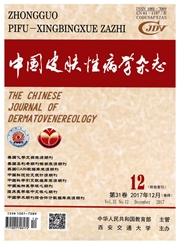

 中文摘要:
中文摘要:
目的研究全反式维A酸(at—RA)对小鼠光老化皮肤的修复作用,并联合应用维A酸受体激动剂和拮抗剂,初步探讨at-RA改善胶原过程中其受体的作用。方法建立ICR小鼠光老化模型,按照实验分组进行at-RA及其受体激动剂和拮抗剂的干预,通过小鼠皮肤及标本HE染色观察at-RA对小鼠光老化皮肤的修复,采用免疫组织化学方法检测真皮胶原蛋白的表达。结果RAR激动剂具有类似at—RA的修复小鼠光老化皮肤及增加I型和Ⅲ型胶原蛋白表达的作用(P〈0.05),而RXR激动剂无此作用(P〉0.05);RAR拮抗剂能够拮抗at-RA和RAR激动剂对光老化皮肤的修复作用及胶原蛋白的改善作用(P〈0.05),而RXR拮抗剂无此作用(P〉0.05)。结论at-RA和RAR激动剂均具有显著修复小鼠光老化皮肤并增加I型和Ⅲ型胶原蛋白表达的作用,维A酸受体机制参与此过程,其中RAR起重要作用。
 英文摘要:
英文摘要:
Objective With the intervention of all-trans retinoic acid (at-RA), retinoic acid receptor agonists and an- tagonists, we aimed to investigate whether retinoic acid receptor contributed to improving the photoaging by at-RA through testing the collagen change of the mice skin. Methods The ICR mice photoaging model were topically treated with at-RA, RAR (retinoic acid receptor) or RXR(retinoid X receptor) agonist/antagonists separately. The changes of the mice skin were analyzed through macroscopical observation, HE staining, and the immunohistochemistry detection of collagen(type I and HI ) . Results Both at-RA and RAR agonists significantly repaired the photoaged skin and increased dermal collagen ( P 〈 0. 05 ), while RXR agonists didn ' t ( P 〉 0. 05 ). RAR antagonists could antagonize the skin repairation and collagen improvement by at- RA and RAR agonists ( P 〈0. 05). Conclusion These results demonstrate that the effect of both at-RA and RAR agonists in repairing the photoaged skin and increasing the collagen may be related to retinoic re- ceptor mechanism, in which RAR is likely to play a key role.
 同期刊论文项目
同期刊论文项目
 同项目期刊论文
同项目期刊论文
 期刊信息
期刊信息
